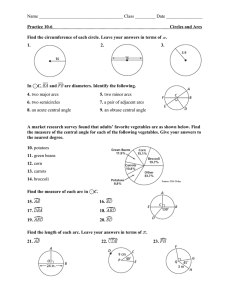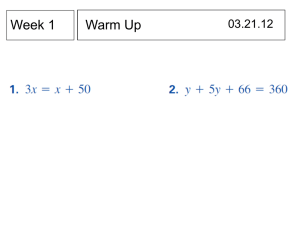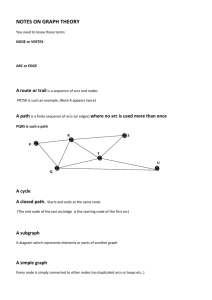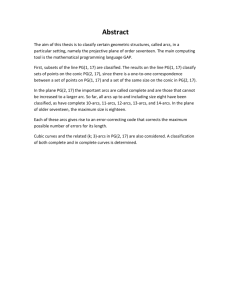On Very Large Scale Assignment Problems WP# 3572-93
advertisement
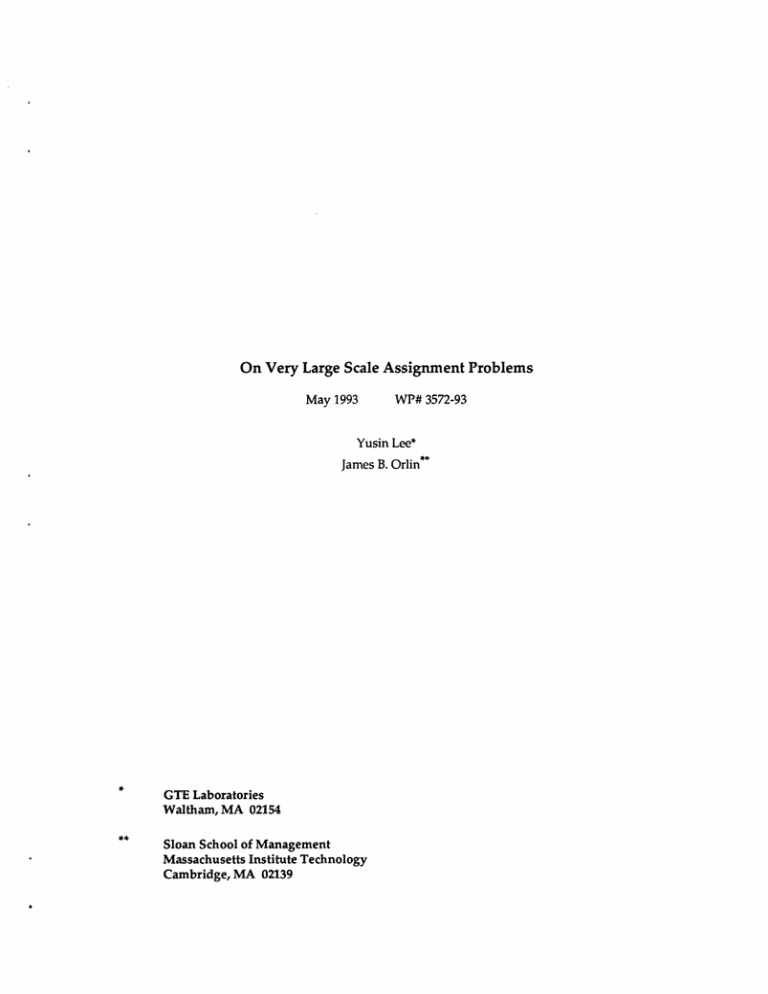
On Very Large Scale Assignment Problems
May 1993
WP# 3572-93
Yusin Lee*
James B. Orlin**
*
**
GTE Laboratories
Waltham, MA 02154
Sloan School of Management
Massachusetts Institute Technology
Cambridge, MA 02139
On Very Large Scale Assignment Problems
Yusin Lee
Department of Civil Engineering, Massachusetts Institute of Technology, Cambridge,
MA 02139 USA
James B. Orlin
Sloan School of Management, Massachusetts Institute of Technology, Cambridge,
MA 02139 USA
Abstract
In this paper we present computational testing results on very large scale
random assignment problems. We consider a fully dense assignment problem
with 2n nodes. Some conjectured or derived properties regarding fully dense
assignment problems including the convergence of the optimal objective function value and the portion of nodes assigned with their kth best arc have been
verified for networks up to n = 100, 000 in size. Also we demonstrate the power
of our approach in solving very large scale assignment problems by solving a
one million node, one trillion arc random assignment problem.
1
Introduction
In this paper we present computational testing results on very large scale random
assignment problems. We consider a fully dense assignment problem with 2n nodes
whose arc costs are identically independently distributed with density f(c) = (r+ 1)cr.
Avram and Bertsimas [3] showed that for these problems lim,_o. (
converges to
some value, where Pn is the objective function value for a 2n-node random assignment
problem. For the case r = 0, f(c) is uniform (0,1). In this case limn_,
E(P,*) is shown
to be bounded between 1.51 and 2, where the lower bound is due to B. Olin [17] and
the upper bound is due to Karp [10].
Another interesting property of the random assignment problem is the fraction of
nodes matched by the kth best arc in an optimum assignment. Dimitris Bertsimas 6]
1
conjectured that at optimum, one half of the nodes are matched by its best adjacent
arc, half of the rest are matched by the second best adjacent arc, and so on. A similar
observation is also made by B. Olin [17].
Only very limited computational testings have been done in the past to verify
these properties. B. Olin [17] carried out some computational studies for networks of
several hundred nodes. Pardalos and Ramakrishnan [18] solved for networks up to
n = 10,000. Networks solved in both research are fully dense. In this research we
used our algorithm to solve a random network of n = 1,000,000 in size. We then
solved an extensive number of instances for networks up to n = 100,000 to verify
the properties described above. We also observed the difference between the cost
distribution of the arcs in the network and the arcs that are in an optimum solution.
In section 2 of the paper we introduce briefly the QuickMatch algorithm [13] that
is used as the assignment problem solver in this research. Computational results are
presented in section 3.
2
2.1
The Algorithm
The Assignment Problem
Consider a problem of matching n persons to n tasks where for each person i and
for each task j there is an associated cost cj of assigning person i to task j. The
assignment problem is the problem of matching n persons to n tasks so as to minimize
the total cost. Although the assignment problem is traditionally phrased in terms
of assigning persons to tasks, it also models applications in a wide range of different
settings. For example, the assignment problem also has applications in vehicle routing
and signal processing, and it is an important relaxation of the traveling salesman
problem. For a survey of the applications, see Ahuja, Magnanti, and Orlin [1].
The standard integer programming version of the assignment problem is defined
as follows:
let
_ { 1 if person i is assigned to task j
0 otherwise.
Minimize E
cijzij
(la)
(i,j)EA
Subject to
zxij = 1
Vj = 1,...,n,
(lb)
:ij = 1
Vi = 1,...,n,
(lc)
iEN
E
jEN
zij > O, integral
V i,j.
(Id)
The assignment problem is a special case of the transportation problem, which in
turn is a special case of the minimum cost flow problem. As is well known, all corner
2
task node k with C(k) < C(w). For other nodes, r(k) or 7 (k) is kept unchanged.
A heuristic used in the QuickMatch algorithm is to run Dijkstra's algorithm and
the Reverse Dijkstra's algorithm alternatively, i.e., initiate the Dijkstra's algorithm
from a person node and a task node alternatively. A second heuristic is to set an
upper bound T for the size of the shortest path trees. If a shortest path tree has
already labeled T permanent nodes and still has not reached a target node, the tree
is abandoned and a new tree is restarted from another node. As shown in the pseudo
code, T is initially set to 2 and doubled at each outer iteration. More details of the
QuickMatch algorithm can be found in Lee and Orlin [13].
A critical part of the algorithm for solving dense assignment problems above is to
verify efficiently whether an optimum solution with respect to the first k arcs is also an
optimum solution to the fully dense network. Let 7r, 7 be an optimum set of dual prices
for the assignment problem restricted to G(k) and x* be the corresponding optimum
flow. It follows from the complementary slackness property of linear programming
that if the reduced cost of an arc (i,j), defined as -ej = cij - i + yj, is greater
than or equal to 0 for all (i,j) E G, then x' is also optimum for G. Let A(k)
be the set of the k lowest cost arcs, and c* be the maximum arc cost in A(k). If
c' > max(7ri - -yj)V(i, j) E A, all arcs in A \ A(k) will have positive reduced cost since
these arcs all have cost greater or equal to c*. Thus an optimum solution with respect
to AL is also an optimum solution with respect to A. Moreover, max(ri - j) can be
calculated in O(n) time. Therefore optimality can be checked efficiently. A pseudo
code of the optimality checking process is shown below.
Subroutine Optimality Check
begin
Let c* be the maximum arc cost in A(k);
Let (r,-y) denote the optimum dual price determined by the algorithm for G(k);
7r = max{7rili a person node};
y; = min{jlj a task node};
if (c* > r*- a) return (r, -y is optimum)
else return (7r,7 is possibly not optimum)
end
3
3.1
Computational Analysis of the Assignment Problem
A Trillion Arc Assignment Problem Instance
As discussed in section 2.2, if one has the freedom to generate arcs in a suitable order,
then one can often solve very large scale fully dense networks without generating
most of the arcs. We demonstrate the power of this approach by solving a fully dense
5
11
network with one million nodes on each side, which has a trillion arcs in total. Using
the algorithm described in section 2.2, we chose 2n log n as the initial number of arcs,
which is approximately 40,000,000. The algorithm terminated in one iteration. The
40 x 106 arc problem was solved in 28 minutes on a CRAY Y-MP M9 2/21000, using 1
CPU and 370 x 106 words memory. Notice that the number of arcs actually generated
and solved is only a very small fraction of the entire set of one trillion arcs. If one
wants to solve the fully dense network in its original form, it will take at least several
thousand times more CPU time and memory space. In the remaining parts of this
paper we will present computational results of up to n = 100, 000 in size. Most of the
instances are solved on a VAX-9000 machine. Networks of that size can be solved in
a few minutes with the QuickMatch algorithm [13].
3.2
The Objective Function Value
Mezard and Parisi [16] predicted that the objective function value of a fully dense
random assignment problem whose arc costs are uniformly distributed in (0, 1) converges to 1- = 1.64493 as the number of nodes n approaches infinity. B. Olin [17]
solved networks of up to n = 250 in size and found P,n, the objective function value
for instances of size n converging to 1.64. Pardalos and Ramakrishnan [18] studied
networks of up to n = 10, 000 in size and was unable to reject the null hypothesis that
P. convergs to 2 as n - oo. In this section we check this conjecture by tracing the
objective function value of fully dense assignment instances up to a size of 100,000
nodes on each side. A total of 26200 networks covering 8 network sizes are studied,
with detailed testing for the cases n = 2000,4000, 8000, 10,000 and 16,000. The
data is shown in figure 2 and related statistics are shown in table 1. The columns
0p,,.p and r7' - are average P, the estimated variance for P, and the variance for
the estimated mean of Pn*, respectively. The last column shows how far the observed
T deviates from ' . For networks sizes that we solved 5000 instances, the observed
average value for Pn is about 1 to 3 standard deviations away from . Assuming
normal distribution for the observed Pn, 3 standard deviations would correspond to
a confidence level of 99.7%, 2 standard deviations corresponds to 95.5%, and 1 standard deviation corresponds to 68.3% (two-tail). We also observe the trend that the
difference decreases as n grows large. The trend that the objective function value
approaches 2 from below agrees with the observation by B. Olin [171 until n=10,000.
Then it seems to bounce around for larger sizes. However, we point out that while
the deviation of TP from Z2- (in standard deviations) seems to remain close to ±1
for n > 16000, one should notice that the data size is very different for n > 20000
networks.
B. Olin [17] found that the objective function value is normally distributed for
instances of n = 250. We verified the distribution for up to n = 16,000 instances.
The quantile-quantile plot for the observed Pn of n=2000, 4000, 8000, and 16000
networks are plotted in figure 3. In all cases all data points lie reasonably close to
6
a-
2000
*4000
.q
i
U
300-
a
100
0O ------1. 10
IMF1.5
1.65
1.60
1.70
1is75
'5
Objpave fihnrm vslu
n
Ob aw fuauoa vlus
£t000
a = 1000
400
300
I
200-
200-
100
I
01I1
.
- _-
1.0
.
.62
Ob
1.64
1.66
1.68
1.70
No.-
0 *A"
.60
.
--
ahume vallu
---
1.65
Objiomw fuou value
Figure 2: Objective function values.
7
iaulrurruuurr.__I__________
_____
~~~~~~~~~~
--
1.70
RlmQb
A.
--
13
--
I
in
15-
0tO
1.62
1.66
144
Vwtn
ObiM
4
I
I
-
I
40o
1.70
1.62
146
144
.u.
Ob
f
Ls
b.
rawtF
n -1000
n m400l
40
--
2,
I
30
I
Is -
I
I
10-
-
°0
ti
M-
143
144
00b
4A
I.' 6
I.
0-
IJf7
1.630
1.43
A10
ob
i. _se b.
I44
fb.
s-n
1450
u-.
Figure 2: (continued)Objective function values.
8
1ASS
a
1m
observations
n
n
5000
5000
5000
5000
5000
400
400
400
2,000
4,000
8,000
10,000
16,000
20,000
40,000
100,000
1.64371
1.64413
1.64451
1.64456
1.64508
1.64440
1.64530
1.64474
.
0.02782
0.01949
0.01429
0.01298
0.01020
0.00965
0.00629
0.00410
0.0003935
0.0002756
0.0002021
0.0001836
0.0001442
0.000482
0.000314
0.000205
P-3.11
-2.91
-2.10
-1.99
1.04
-1.12
1.16
-0.97
Table 1: Statistics of objective function values. All networks are fully dense.
the 45 degree line, indicating that the data is distributed very close to normal.
3.3
Arc Preference of Optimum Solutions
Consider a fully dense assignment problem and a corresponding optimum solution.
For each arc (i,j) E A, we say that (i,j) E A k if (i,j) is the k-th least cost arc
incident to i or if (i,j) is the k-th least cost arc incident to j or both. Let Aopt be the
set of arcs used in an optimum solution. Also let A t be the intersection of Ak and
Ao,t. In other words, A t is the set of arcs that are the kth best adjacent arc of one of
its end nodes and also in the optimum solution. In this section we study the number
of arcs in A k for each k. The following is a conjecture by Dimitris Bertsimas [6] and
B. Olin [17].
Conjecture 1 limn._ clo4
'=
1
Let i be a node and let mate(i) be the node assigned to i in A*. Also let i
be the number of arcs adjacent to node i that has cost less than ci,mate(i). In other
= k - 1}. We verify conjecture 1 by
words, Ak t = (i,j) E Aopt,i = k - 1 or
observing i for the nodes in the network. Figure 4 shows the plot of observed hti,
where the horizontal axis are i and the vertical axis are observation counts, plotted
in log scale. The straight line in each of the plots corresponds to the i predicted
by conjecture 1. One can see visually that the data supports the conjecture for the
networks studied. We divide the variance of the observed data by the variance of its
predicted value by conjecture 1. This is an analog of the standard way of calculating
R2 as a measure of the goodness of fit for regression models. However, the ratio in
this case will not be restricted to be less than or equal to 1. The calculated ratio
for n = 2,000, 4,000, 8,000, 10,000, 16,000, 20,000, 40,000, and 100,000 are 1.022,
0.996, 0.984, 1.004, 0.996, 0.999, 1.000, 0.993, respectively. All these ratios are very
close to 1.0, which indicates that the observed data is very close to what conjecture 1
9
t
R
II
f
II
II
U
-4
0
-2
ouan
o Sf
-4
^2
2
0
@.
sv'd NewI
of W.-ftd *M.gI
it
I
I
J1
'T
I
.4
-a
0
O-dma
-4
t
.2
I
0
C0 mO d Sbt
o StWUftw N.uC
NomI
Figure 3: Quantile-quantile plot for observed objective function values.
10
predicts. We also calculate the correlation between observed and predicted data. In
all cases the coefficient of correlation is 1.000.
Next we study nlin(Ki, j) for each arc (i,j) E A.
In almost all cases the
maximum of min(Ki, cj) is less than 10. This suggests that for random networks up
to n = 100, 000 in size, in most cases the union of the 10 least cost arcs adjacent to each
node is sufficient to yield an optimum solution to the original fully dense network. The
size of this union will be no more than 20n. For n = 100, 000, 20n < 2n log n - 33n.
This seems reasonable since one will need more than 20n arcs to cover the 10 least
cost arcs for each node. The observed data is plotted in figure 5. We observe that
the graphs look similar to their counterparts in figure 4 except for a different slope.
Let
j) = k}. Table 2 shows the regression results
t = {(i, j) E A : min(Ki,
on min(si, nj) and A.
The straight line in each of the plots in figure 5 is the
corresponding fitted line. Based on our observed data and the regression result, we
have the following conjecture.
Conjecture 2
3.4
imn-1
=
k,8
where 0.26 <
< 0.30.
Cost Distribution of the Arcs Used in an Optimum Solution
The cost distribution of the arcs in A t is different from that of the arcs in A k. If
conjecture 1 is true and if the two distributions were the same, then the objective
function value would converge to 2 as n becomes large (which is not the case), since the
expected cost of arcs in Ak is _k. We verify this by plotting the arc-cost percentile
graph as shown in figure 6. In the graphs the horizontal axis is the arc cost, the
vertical axis is the percentage of arcs in Ak (solid line) or A t (dotted line) whose
cost is less than some cost. Figures 6a, 6b, 6c, and 6d show the data for k = 1, 2, 3,
and 4, respectively. The curves in figures 6b, 6c, and 6d clearly shows that cost of arcs
in Ak and A't are of different distributions for k = 2, 3, and 4, while A t includes
more low cost arcs in A&. However, the two curves in figure 6a almost overlap each
other. This leads to the following conjecture.
Conjecture 3 In an assignment problem, the distribution of the cost of arcs in Al
is the same as the arcs in A't.
We provide a heuristic (non-rigorous) argument as to why the conjecture might
be valid. We conjecture that this heuristic argument can be made approximately
rigorous, but we are unaware of such a proof. Let ij = cq - min(cij: j = 1,... ,n).
Then :ij = 0 for (i,j) E A l , but :ij is asymptotically uniformly distributed (0,1) for
(i,j) Al. Also, an optimum solution with respect to is optimum with respect to
c. In optimizing with respect to c, there will be no particular pattern in the arc costs
11
III
n
2000
4000
8000
10000
16000
20000
40000
regression
y = 0.2672
(-48)
y = 0.252'
(-74)
y = 0.2722
(-46)
y = 0.2652
(-61)
y = 0.259
(-74)
y = 0.278'
(-58)
y = 0.26.5
R2
0.991
0.996
0.990
0.994
0.996
0.993
0.988
(-49)
100000
y = 0.2642
(-86)
0.996
Table 2: Regression results for various network sizes, where x is mrin(i,
j) and y is
II'1. Numbers in parenthesis are the t values corresponding to the logarithm (base
2) of the corresponding data. Data for iterations 7 and 8 for n = 4000 network, and
also iteration 7 for n = 2000 network are dropped from the regression.
12
tlO2.
-i 4~0
I
1
0
2
3
4
Orde.
6
S
of W.
en
a
7
9
to
o
II
I
2
ead adjmuw7 "a
3
4
S
=-.
0
1
2
3
4
S
6
6
7
Ordwingoem,
* 9
10 11 12 13 14
aMsh.y It
nm 100
I
Ordegf wd
m I ha ad
9
$
10 11
12
13
0
I
X
3
4
S
*
*
Ordwinsm In M
lo
Figure 4: Observed n.
13
*
jlm
t
10 II
3 No
12
1
14
a. 16.016
n - 00a
I
0
I
2 3 4 S 6 7 I
Ofld4r
of -
in
9
10 II 12
.ml J
3i I1
S I
17
0
2
y ti
4
4
O0<ut
8
n -40.000
O I
2
3
4
S
4 7
OrNbe de
8
nl
9 10 It 12 13 14 1S 16 17
0
b1.ad u.dlpsy lb
I 4
*
*
14
1
14
If
I
30
22 U
M
100.000
to
OWNe do
Figure 4: (continued)Observed
10
dofu h ed
miw.m.y It
.
14
.ir
16 IIs
ah ,el y tit
2·j
- 4100
I
t0
0
1
2
Ordwbf ofw
4
3
khi
.i djiney Ht.
S
6
w
t.o
7
8
1
0
,W.
2
Orduq M
3
h iw
M.
4
,
4
S
I.
S
9
4
7
7
WWWl f_d.
o Wed.
. Ioaoo
1
0
2
Od w*m.# h11de dJw
S3
4
omr d
6
7
0
OdW
. woe.6
1
2
kO
_b
3
4
adtjtty tRe.miubr o
s
wofe.
Figure 5: min(ri, #j) for arcs (i,j) used in an optimum solution.
15
_(__*__LYI___^___ils---___I___
l-I4.000
. 2.000
I
1
0
Ordwmt
.
2
3
4
3
h eaeh adjmfaey l.
m
7
6
0
a
oh t. ewd.
fw
mA.
1
2
4
3
Ordreg e fedtisf
h
.m.lm
s
7
a
ftllr tw-
.
9
100a.00
a - 40.00
~
6
S
.my
~~
-
S
10000'
to
*
-
I
-
I
-
I
-""
O
I
2
3
4
Otdwhio
mu
-
.e
I
S
lk ml
I
6
*
7
f
Figure 5: (continued)min(Ki,
ij)
2
3
Ordwfof -
1
i -i
0
9
. mdamm
4
S
a
7
*
9
10
lino. Mtlw of"ete wd.
for arcs (i,j) used in an optimum solution.
16
of Al and so the costs for arcs in A t should have the same distribution as the costs
for arcs in A'. However, one would expect that the costs of arcs in A2t would be less
than the arc costs in A 2 .
Figure 7 shows the cost distribution of arcs used in an optimum solution for an
=2000 network. Figure 7a, 7b, 7c, and 7d corresponds to the arcs in Al A2
A3 t and A ,t respectively. Figure 8 shows the distribution of the arc costs in A',
A 2 , A 3 , and A 4 of the same network. Figure 9 shows the cost distribution of all arcs
in A* of various networks.
3.5
Generalization of the Arc Cost Distribution
In previous sections we focus on random networks whose arc costs are distributed with
density f(c) = (r + 1)c" for the case r = 0. In this section we focus on the case r 0.
Avram and Bertsimas [3] showed that for these problems limn-o,,
converges to
some value. Unfortunately they are unable to solve for the value it converges to. In
this section we try to verify the convergence prediction and achieve a first estimate
on what the limit might be. Table 3 shows the statistics for fully dense networks
whose sizes range from n = 2000 to n = 8000 and r = 2, 3, 5, and 10. The data does
agree with the prediction. Also we observe that the objective function values are very
different from the case r = 0.
We also observed that for the r > 0 case, the number of arcs k needed such that
an optimum solution to G(k) is also an optimum solution to G is much higher than
that of the r = 0 case. We show this by observing min(Ki, irj). Figure 10 shows
min(Ki, j) for n = 20,000 networks, where r = 2, 3, 5, and 10 in figures 10a, 10b,
10c, and 10d, respectively. One can see the difference by comparing figure 10 to
figure 5.
Acknowledgments
The authors would like to thank Cray Research, Inc. and to John Gregory in
particular for providing us access to the Cray Y-MP, on which we solved the trillion
arc problem. We would also like to thank Dimitris Bertsimas and Rakesh Vohra for
their suggestions concerning a draft of the manuscript, for their conjectures on large
scale assignment problems, and for their pointers to the literature. This research is
supported in part by grant AFOSR-88-0088 from the Air Force Office of Scientific
Research, and by a grant from the United Parcel Service.
References
[1] Ravindra K. Ahuja, Thomas L. Magnanti, and James B. Orlin. Network flows:
Theory, Algorithms and Applications. Prentice Hall, 1993.
17
(i
d
Iat
Mrmtprcuulhq
of
b_t *e c med
m d.)
iI
i
I
I
I
Ii
mi 1 )
I
I8
0.000
0.0
OA4
0002
A00
0.003
0001
A eo.
0M
HEooX
b.
a.
nct
p mi
-t
tm eof P,
)
mJ.
wemb
t ar h
t W e oW fe
*It
iI
iI
I
II
)
I
I
I
Is
i
0.000
oWl
0.003o
o
0o04
000
Oat
.00
,,,,
0am
a
u
rlru
a
he'sz
Are co.
C.
oWl
d.
Figure 6: The arc-cost percentile graphs. The horizontal axis is the arc cost, the
vertical axis is the percentage of arcs in Ak (solid line) or A t (dotted line) whose
cost is less than some cost.
18
An est dsqbu*Is Wi. I asm vw d
(Am b spOam mL_
_
Oy)
h
dse.
3 X
a"-Xb
(AN n i1_
W v__^brs
0001
0
e I&
Mdrm I
l~~)
d)
d*
,
20
O
000
I
A. ~o
:,
I
0.003
O04
h ImMcm
e of mdh amd
O0
A.n m
b.
a.
A
et dHb b
te 3hi Int eoM s of
(An Impbw qw
om)
mln
.
An -m d
lbemt k i
12D
w
30-
40.
10-
0*
0-
0l 01
O
0.00
004
o0
0.01
0A0
o0.
000
0m0
09o0
An -a
d.
C.
Figure 7: Cost of arcs in A
A2
A3
19
----- ·------·-·---------·----
----------- ----------
t,
and A4,t of an n = 2000 network.
Ate
me
1 - d emh bd.
fV*
e th bIt
Ar eed dl
bM
r d
m
oid
nd..
S00-
4,I
200
I
1t0
"Nom0004
O.02
0.000
0.00
0001
0004
003
0.002
0.00
A~
A e-t
b.
a.
for t.
Ar ete disnei
t we of mLh nod.
3rd oe
Ago dlim
t
f
001
oa
Ih lb
t
d
wt of
node.
~JU'q
..
|,
| |~~~~~~:··::
200-
.... |
.. .
~
I
1:S ,....,.
....
.....
.....
. ._
".
.....
:
.....
i
100'
I
o
0
_-'I
I '*''**
Wm
:-
:::
_I
.001
Oam0
I
-
_rIP
E
"'"o~or~--
I.
O
004
a
0·:*:'
0.000
000
An
An -a
C.
o.a3
0004
__
0005
sao
d.
Figure 8: Cost of arcs used in A', A 2 , A 3 , and A 4 of an n = 2000 network.
20
n 2I0
a-4A,
I
I
0.0012
Cormt
od
oa.4
rusetd h
OO
olo
0.00
a
o..o
o
ooo
lWl
Cortm
na S
M
O.00144OOl
oon
o
o40o
d h mopmmm m
mm
*10.
I
I
om
Mns
o
0 730
om75
0.00112S
00100
0n_
O
CoG off.dm u s
m op mhmmslfi
sOsE mm
Figure 9: Cost of arcs used in optimum solutions.
21
0.0012
oAWi
III
fn14.000
- 2.00
I
I
Omao
C
o
tdewm
ased
mn e
an
h,.
0o0
Oa
C_
00m
def w ea ed
n - 40.000
n
0004MA
moA
Omom
h
, opimsl,
mm
a.
uadon
00.000
I
I
.
.000
OCOOB
Cow o
0.00016
mI..I
w us.ed i
010400
-k
.0032
D0.00040
0,
oueaes
0
.
0000
.
0.00012
Coawof am wo umsdi i o imusurolmin
Figure 9: (continued)Cost of arcs used in an optimum solution.
22
.
W0.00018
n- 20m
r- 2
*.eo
f.S
J
0
2
Ordwlof
4
6
br
md.w. e
10
8
t.
12
Ullr
Od
14
b I.
Is
Is
0
irds.
.
.
I
2
4
4
Odigoft f
.
ad
e B
.
.
I
I
.
i
t10
12
14
If
I1
0
If ullr
UK
bdI.
l.
b.
a.
n-0A
v-5
I .
.o00
.o10
IOW0'
I
A
v
---
--
___
i I
0
2
4
Ordmbtmd n
C.
X
I
Bem
10
abe.!fq
12
14
mlla
1A
f
IS
twl
0
2
0
24
2
4
OrldWll*f
.
4
I
10
t12 14
sblelb .m7 l l bif.
14
I
0
12
24
l d *twmu.
d.
Figure 10: min(,i, j) for arcs (i,j) used in an optimum solution. Network size is
n = 20,000. Arc cost distribution is r = 2, 3, 5, and 10.
23
I-·li--.....
·-
-·---
r
2
3
5
10
fnln
2000
8000
20000
2000
8000
20000
2000
8000
20000
2000
8000
20000
166.596
421.770
776.065
306.165
865.579
1721.570
565.898
1792.618
3850.566
997.464
3516.254
8088.215
ap
aTP
0.893
1.361
1.835
1.197
2.616
2.577
2.410
2.433
4.571
2.237
3.160
4.551
0.200
0.304
0.410
0.268
0.585
0.576
0.539
0.544
1.022
0.500
0.707
1.018
Fpn/n1L
1.0495
1.0544
1.0533
1.0237
1.0233
1.0237
1.0043
1.0021
1.0031
0.9953
0.9950
0.9950
Table 3: Statistics of objective function values for r : 0. All networks are fully dense.
Number of observations are 20 for all cases.
[2] Mustafa Akgul. A forest primal-dual algorithm for the assignment problem.
Bilkent University, Ankara, Turkey, Research Report: IEOR-9014, 0(0):1-2, Oct
1990.
[3] Florin Avram and Dimitris Bertsimas. On a characterization of the minimum
assignment and matching in the independent random model. In The third symposium in integer programming and combinatorial optimization, Enrice, Italy,
April 1993.
[4] M. L Balinski. Signature methods for the assignment problem.
Research, 33(3):527-536, May-Jun 1985.
Operations
[5] Dimitri P. Bertsekas. The auction algorithm for assignment and other network
flow problems: A tutorial. Interfaces, 20(4):133-149, Jul-Aug 1990.
[6] Dimitris J Bertsimas, 1993. Personal communication.
[7] Harold N. Gabow and Robert E. Tarjan. Faster scaling algorithms for network
problems. SIAM Journal on Computing, 18(5):1013-1036, Oct 1989.
[8] Ming S. Hung. A polynomial simplex method for the assignment problem. Operations Research, 31(3):595-600, May-Jun 1983.
[9] Ming S. Hung and Walter O. Rom. Solving the assignment problem by relaxation.
Operations Research, 28(4):969-982, Jul-Aug 1980.
24
[10] Richard M. Karp. An upper bound on the expected cost of an optimal assignment. Technical report, Computer Science Division, University of California,
Berkeley.
[11] Richard M. Karp. An algorithm to solve the mxn assignment problem in expected
time O(mn log n). Networks, 10:143-152, 1980.
[12] J. Kennington and Z. Wang. A shortest augmenting path algorithm for the
semi-assignment problem. Operations Research, 40(1):178-187, Jan-Feb 1992.
[13] Yusin Lee and James B. Orlin. QuickMatch: A very fast algorithm for the
assignment problem. Submitted to Mathematical Programming., 1993.
[14] Vahid Lotfi. A labeling algorithm to solve the assignment problem. Computers
and Operations Research, 16(5):397-408, 1989.
[15] G. M. Megson and D. J. Evans. A systolic array solution for the assignment
problem. The computer journal, 33(6):562-569, 1990.
[16] M. Mezard and G. Parisi. Replicas and optimization. Journalde physique Lettres.
[17] Birgitta Olin. Asymptotic Properties of Random Assignment Problems. PhD
thesis, Royal Institute of Technology, Stockholm, Sweden, 1992.
[18] P. M. Pardalos and K. G. Ramakrishnan. On the expected optimal value of
random assignment problems: Experimental results and open questions.
25
